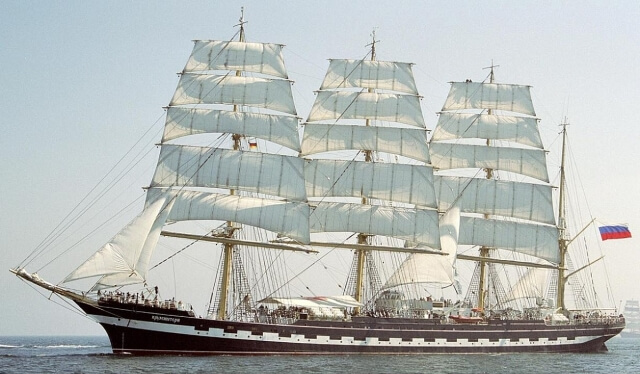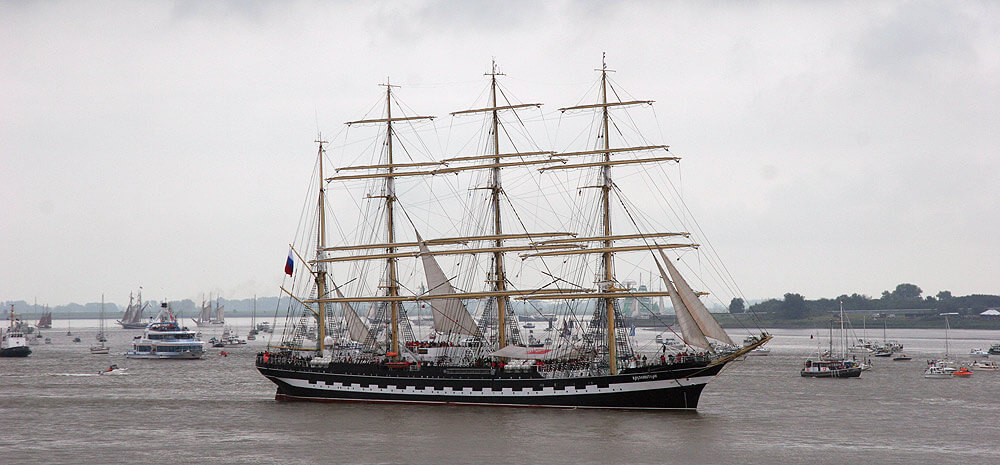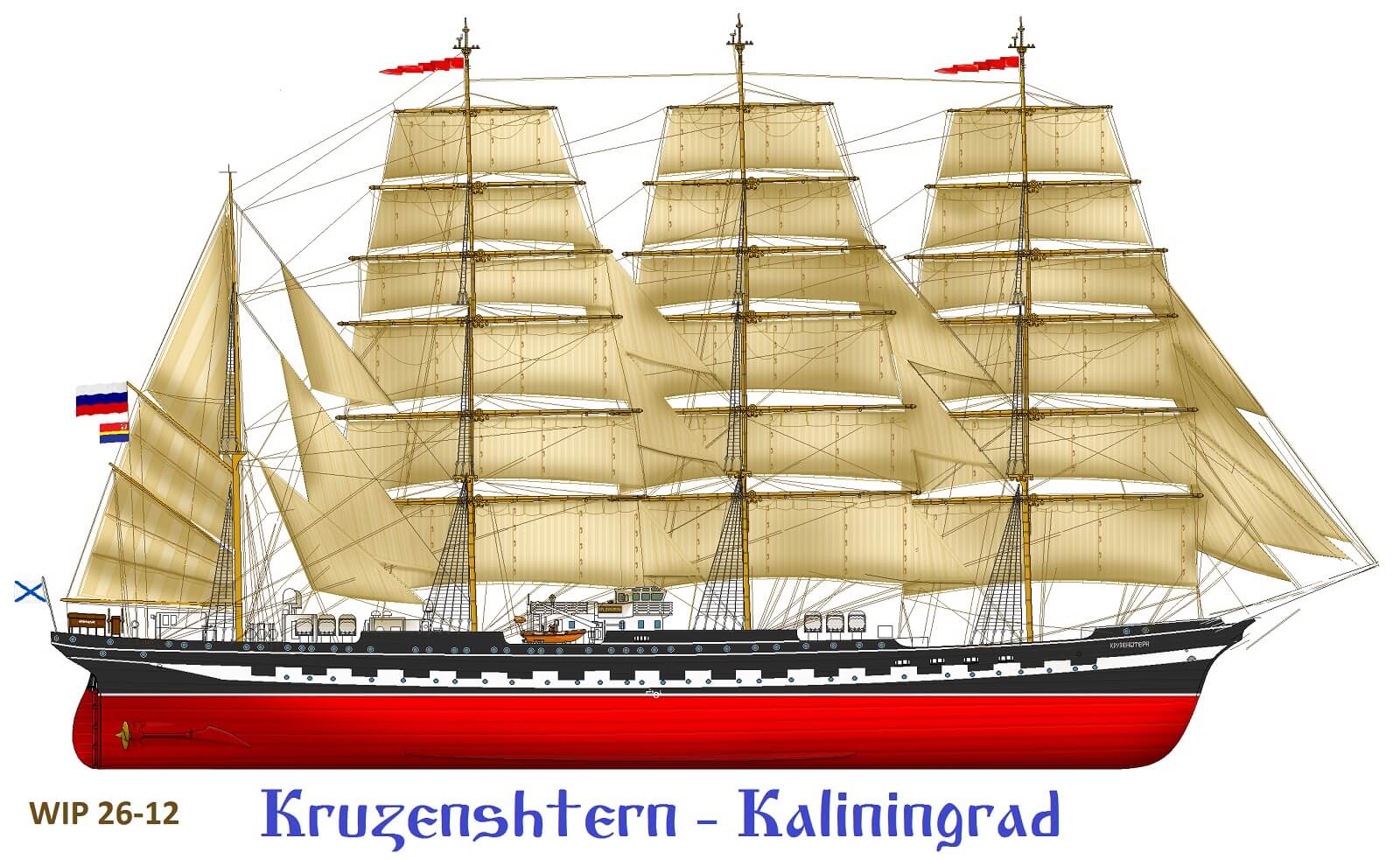⚓ Kruzenshtern ⚓
 full rigged barge ex. Padua - the last of the P-Liners 1926
full rigged barge ex. Padua - the last of the P-Liners 1926



 Röviden...
Röviden...
A Kruzenshtern a világ második legnagyobb vitorlás hajója a másik orosz hajó, a Sedov után. Eredetileg Padua néven Németországban építették az 1920-as években a "Flying P Line" számára, melynek az összes hajójának neve P-vel kezdődött. Ma már csak az ex-Padua vitorlázik. A Pamir elsüllyedt egy hurrikánban az Azori-szigeteknél, a Peking múzeumhajóként áll New Yorkban, a Pommern szintén múzeumhajó a finnországi Mariehamn-ban, a Passat-ot pedig a németországi Travemündében ifjúsági táborként használják, de már nem hajózik.

1946-ban a Szovjetúnió háborús jóvátételként kapta meg a Padua-t, s átnevezték Kruzensthernre a híres orosz navigátor és hidrográfus után. Könnyen felismerhető jellegzetes fekete-fehér oldaláról; a festett ágyúnyílások közös jellemzője volt a Kelettel kereskedő hajóknak, hogy hadihajóra emlékeztető külsejükkel elriasszák a kalózokat.
Műszaki adatok:
Vitorlázat: négyárbocos barkAnyakikötő: Kallingrad
Lobogó: orosz
Építés éve: 1926
Felújítva: 1968-72
Teljes hossz: 114,50 m
Vízvonalhossz: 104,30 m
Szélesség: 14,05 m
Merülés: 7,2 m
Vitorlafelület: 3553 m2
Vízkiszorítás: 6400 t
Árboc magasság: 56 m
Főgép teljesítmény: 2×1000 LE
Állandó legénység: 70 fő
Vendég legénység: 164 fő

The Kruzenshtern or Krusenstern is a four masted barque and tall ship that was built in 1926 at Geestemünde in Bremerhaven, Germany as the Padua (named after the Italian city). She was surrendered to the USSR in 1946 as war reparation and renamed after the early 19th century Baltic German explorer in Russian service, Adam Johann Krusenstern (1770-1846). She is now a Russian Navy sail training ship.
Of the four remaining Flying P-Liners, the former Padua is the only one still in use, mainly for training purposes, with her home ports in Kaliningrad (formerly Königsberg) and Murmansk. After the Sedov, another former German ship, she is the largest traditional sailing vessel still in operation.
As Padua
Launched in 1926 as the last of the P-Liners, the Padua was commissioned as a , used among other things to ship construction material to Chile, South America, returning with saltpeter around Cape Horn. Later she transported wheat from Australia. Her maiden voyage from Hamburg to Talcahuano, Chile took 87 days. In 1933–1934 she took a record-breaking 67 days from Hamburg to Port Lincoln in South Australia. Prior to World War II she made 15 long trips to Chile and Australia. Her fastest voyage was in 1938–1939, from Hamburg via Chile to Australia and back to Hamburg in 8 months and 23 days under Captain Richard Wendt — a World record voyage for tall ships that has never been broken.
Like all P-liners, Padua was painted according to the colours of the German national flag of the German Empire era: black (hull above water, topsides), white (waterline area) and red (underwater body).

At Sail Bremerhaven 2005
As Kruzenshtern
On January 12, 1946 she was surrendered to the USSR and integrated into the Baltic Fleet of the Soviet Navy. She was moored in Kronstadt harbour until 1961 where she underwent major repairs and a refit (e.g. the installation of her first engines) for her missions for the Hydrographic Department of the Soviet Navy. From 1961 to 1965 she undertook many hydrographic and oceanographical surveys for the Academy of Sciences of the USSR in the Atlantic Ocean, the Caribbean, and Mediterranean, and was used as a training vessel for naval cadets. In 1965 she was transferred to the USSR Ministry of Fisheries in Riga to be used as a schoolship for future fishery officers.
From 1968-72 a major modernisation took place, installing her current set of engines and applying her current hull paint - black with a wide white stripe with black rectangles intended to give the illusion of gunports. Kruzenshtern led the international procession of tall ships into New York Harbor for Operation Sail on Sunday, July 4, 1976.
In January 1981 she was transferred to the "Estonian Fisheries Industry" at Tallinn and in 1991 she became part of the "State Baltic Academy of the Fisheries" fleet with her new home port in Kaliningrad.
The Kruzenshtern takes part in many international regattas. After the dissolution of the Soviet Union funding became a problem, so passengers are carried for that purpose. In 1995-96 she circumnavigated the World in the trail of her namesake. She again sailed around the World in 2005-06 to commemorate the 200th anniversary of Krustenstern's circumnavigation.
The ship was used in three German films - Die Meuterei auf der Elsinore (1935); Herz geht vor Anker (1940) and Große Freiheit Nr. 7 (1944), as well as a number of Russian and Soviet films.
On 23 June 2009 while she was en route to the Charleston, South Carolina Harborfest, her foremast was damaged in a storm off Bermuda when the sail backed and snapped the mast.
On 3 May 2010 she stopped in Bremerhaven after a trip of five months with stops in Vancouver for the 2010 Winter Olympics and in Cuba, after which she returned to Kaliningrad
